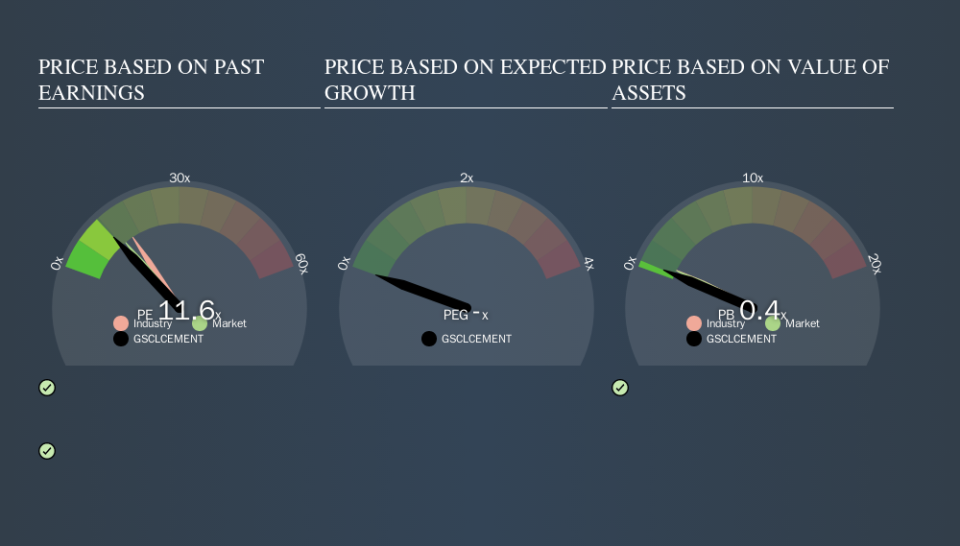Does Gujarat Sidhee Cement Limited's (NSE:GSCLCEMENT) P/E Ratio Signal A Buying Opportunity?

The goal of this article is to teach you how to use price to earnings ratios (P/E ratios). To keep it practical, we'll show how Gujarat Sidhee Cement Limited's (NSE:GSCLCEMENT) P/E ratio could help you assess the value on offer. What is Gujarat Sidhee Cement's P/E ratio? Well, based on the last twelve months it is 11.63. In other words, at today's prices, investors are paying ₹11.63 for every ₹1 in prior year profit.
Check out our latest analysis for Gujarat Sidhee Cement
How Do I Calculate A Price To Earnings Ratio?
The formula for price to earnings is:
Price to Earnings Ratio = Share Price ÷ Earnings per Share (EPS)
Or for Gujarat Sidhee Cement:
P/E of 11.63 = ₹19.00 ÷ ₹1.63 (Based on the year to September 2019.)
Is A High Price-to-Earnings Ratio Good?
A higher P/E ratio means that buyers have to pay a higher price for each ₹1 the company has earned over the last year. All else being equal, it's better to pay a low price -- but as Warren Buffett said, 'It's far better to buy a wonderful company at a fair price than a fair company at a wonderful price.
Does Gujarat Sidhee Cement Have A Relatively High Or Low P/E For Its Industry?
The P/E ratio indicates whether the market has higher or lower expectations of a company. The image below shows that Gujarat Sidhee Cement has a lower P/E than the average (15.7) P/E for companies in the basic materials industry.
Its relatively low P/E ratio indicates that Gujarat Sidhee Cement shareholders think it will struggle to do as well as other companies in its industry classification. While current expectations are low, the stock could be undervalued if the situation is better than the market assumes. If you consider the stock interesting, further research is recommended. For example, I often monitor director buying and selling.
How Growth Rates Impact P/E Ratios
Generally speaking the rate of earnings growth has a profound impact on a company's P/E multiple. Earnings growth means that in the future the 'E' will be higher. And in that case, the P/E ratio itself will drop rather quickly. A lower P/E should indicate the stock is cheap relative to others -- and that may attract buyers.
Gujarat Sidhee Cement's earnings per share fell by 28% in the last twelve months. But over the longer term (5 years) earnings per share have increased by 4.4%.
A Limitation: P/E Ratios Ignore Debt and Cash In The Bank
Don't forget that the P/E ratio considers market capitalization. So it won't reflect the advantage of cash, or disadvantage of debt. Theoretically, a business can improve its earnings (and produce a lower P/E in the future) by investing in growth. That means taking on debt (or spending its cash).
Such spending might be good or bad, overall, but the key point here is that you need to look at debt to understand the P/E ratio in context.
So What Does Gujarat Sidhee Cement's Balance Sheet Tell Us?
Since Gujarat Sidhee Cement holds net cash of ₹52m, it can spend on growth, justifying a higher P/E ratio than otherwise.
The Bottom Line On Gujarat Sidhee Cement's P/E Ratio
Gujarat Sidhee Cement has a P/E of 11.6. That's below the average in the IN market, which is 13.1. The recent drop in earnings per share would make investors cautious, the healthy balance sheet means the company retains potential for future growth. If that occurs, the current low P/E could prove to be temporary.
Investors should be looking to buy stocks that the market is wrong about. If the reality for a company is not as bad as the P/E ratio indicates, then the share price should increase as the market realizes this. We don't have analyst forecasts, but you might want to assess this data-rich visualization of earnings, revenue and cash flow.
But note: Gujarat Sidhee Cement may not be the best stock to buy. So take a peek at this free list of interesting companies with strong recent earnings growth (and a P/E ratio below 20).
We aim to bring you long-term focused research analysis driven by fundamental data. Note that our analysis may not factor in the latest price-sensitive company announcements or qualitative material.
If you spot an error that warrants correction, please contact the editor at editorial-team@simplywallst.com. This article by Simply Wall St is general in nature. It does not constitute a recommendation to buy or sell any stock, and does not take account of your objectives, or your financial situation. Simply Wall St has no position in the stocks mentioned. Thank you for reading.


